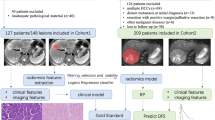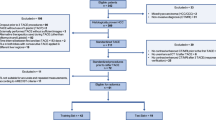Abstract
Purpose
To develop a model based on whole-liver radiomics features of pre-treatment enhanced MRI for predicting the prognosis of hepatocellular carcinoma (HCC) patients undergoing continued transarterial chemoembolization (TACE) after TACE-resistance.
Materials and Methods
Data from 111 TACE-resistant HCC patients between January 2014 and March 2018 were retrospectively collected. At a ratio of 7:3, patients were randomly assigned to developing and validation cohorts. The whole-liver were manually segmented, and the radiomics signature was extracted. The tumor and liver radiomics score (TLrad-score) was calculated. Models were trained by machine learning algorithms and their predictive efficacies were compared.
Results
Tumor stage, tumor burden, body mass index, alpha-fetoprotein, and vascular invasion were revealed as independent risk factors for survival. The model trained by Random Forest algorithms based on tumor burden, whole-liver radiomics signature, and clinical features had the highest predictive efficacy, with c-index values of 0.85 and 0.80 and areas under the ROC curve of 0.96 and 0.83 in the developing cohort and validation cohort, respectively. In the high-rad-score group (TLrad-score > − 0.34), the median overall survival (mOS) was significantly shorter than in the low-rad-score group (17 m vs. 37 m, p < 0.001). A shorter mOS was observed in patients with high tumor burden compared to those with low tumor burden (14 m vs. 29 m, p = 0.007).
Conclusion
The combined radiomics model from whole-liver signatures may effectively predict survival for HCC patients continuing TACE after TACE refractoriness. The TLrad-score and tumor burden are potential prognostic markers for TACE therapy following TACE-resistance.
Graphical Abstract








Similar content being viewed by others
References
Reig M, Forner A, Rimola J, et al. BCLC strategy for prognosis prediction and treatment recommendation: the 2022 update. J Hepatol. 2022;76(3):681–93. https://doi.org/10.1016/j.jhep.2021.11.018.
Han G, Berhane S, Toyoda H, et al. Prediction of survival among patients receiving transarterial chemoembolization for hepatocellular carcinoma: a response-based approach. Hepatology. 2020;72(1):198–212. https://doi.org/10.1002/hep.31022.
Golfieri R, Bargellini I, Spreafico C, et al. Patients with Barcelona clinic liver cancer stages B and C hepatocellular carcinoma: time for a subclassification. Liver Cancer. 2019;8(2):78–91. https://doi.org/10.1159/000489791.
Ebeling Barbier C, Heindryckx F, Lennernäs H. Limitations and possibilities of transarterial chemotherapeutic treatment of hepatocellular carcinoma. Int J Mol Sci. 2021;22(23):13051. https://doi.org/10.3390/ijms222313051.
Kudo M, Kawamura Y, Hasegawa K, et al. Management of hepatocellular carcinoma in Japan: JSH consensus statements and recommendations 2021 update. Liver Cancer. 2021;10(3):181–223. https://doi.org/10.1159/000514174.
Raoul JL, Gilabert M, Piana G. How to define transarterial chemoembolization failure or refractoriness: a European perspective. Liver Cancer. 2014;3(2):119–24. https://doi.org/10.1159/000343867.
Kudo M, Matsui O, Izumi N, et al. JSH consensus-based clinical practice guidelines for the management of hepatocellular carcinoma: 2014 update by the liver cancer study group of Japan. Liver Cancer. 2014;3(3–4):458–68. https://doi.org/10.1159/000343875.
Cheng AL, Amarapurkar D, Chao Y, et al. Re-evaluating transarterial chemoembolization for the treatment of hepatocellular carcinoma: consensus recommendations and review by an international expert panel. Liver Int. 2014;34(2):174–83. https://doi.org/10.1111/liv.12314.
Yang C, Luo YG, Yang HC, et al. Effects of early TACE refractoriness on survival in patients with hepatocellular carcinoma: a real-world study. J Hepatocell Carcinoma. 2022;9:621–31. https://doi.org/10.2147/jhc.S373112.
Zhong BY, Wang WS, Zhang S, et al. Re-evaluating transarterial chemoembolization failurerefractoriness: a survey by chinese college of interventionalists. J Clin Transl Hepatol. 2021;9(4):521–7. https://doi.org/10.14218/JCTH.2021.00049.
Kadalayil L, Benini R, Pallan L, et al. A simple prognostic scoring system for patients receiving transarterial embolisation for hepatocellular cancer. Ann Oncol. 2013;24(10):2565–70. https://doi.org/10.1093/annonc/mdt247.
Cappelli A, Cucchetti A, Cabibbo G, et al. Refining prognosis after trans-arterial chemo-embolization for hepatocellular carcinoma. Liver Int. 2016;36(5):729–36. https://doi.org/10.1111/liv.13029.
Kim BK, Shim JH, Kim SU, et al. Risk prediction for patients with hepatocellular carcinoma undergoing chemoembolization: development of a prediction model. Liver Int. 2016;36(1):92–9. https://doi.org/10.1111/liv.12865.
Wang Q, Xia D, Bai W, et al. Development of a prognostic score for recommended TACE candidates with hepatocellular carcinoma: a multicentre observational study. J Hepatol. 2019;70(5):893–903. https://doi.org/10.1016/j.jhep.2019.01.013.
Zou ZM, An TZ, Li JX, et al. Predicting early refractoriness of transarterial chemoembolization in patients with hepatocellular carcinoma using a random forest algorithm: a pilot study. J Cancer. 2021;12(23):7079–87. https://doi.org/10.7150/jca.63370.
Chen L, Yu CX, Zhong BY, et al. Development of TACE refractoriness scores in hepatocellular carcinoma. Front Mol Biosci. 2021;8:615133. https://doi.org/10.3389/fmolb.2021.615133.
Niu XK, He XF. Development of a computed tomography-based radiomics nomogram for prediction of transarterial chemoembolization refractoriness in hepatocellular carcinoma. World J Gastroenterol. 2021;27(2):189–207. https://doi.org/10.3748/wjg.v27.i2.189.
Wang TC, An TZ, Li JX, et al. development and validation of a predictive model for early refractoriness of transarterial chemoembolization in patients with hepatocellular carcinoma. Front Mol Biosci. 2021;8:633590. https://doi.org/10.3389/fmolb.2021.633590.
Liu F, Liu D, Wang K, et al. deep learning radiomics based on contrast-enhanced ultrasound might optimize curative treatments for very-early or early-stage hepatocellular carcinoma patients. Liver Cancer. 2020;9(4):397–413. https://doi.org/10.1159/000505694.
Ji GW, Zhu FP, Xu Q, et al. Machine-learning analysis of contrast-enhanced CT radiomics predicts recurrence of hepatocellular carcinoma after resection: a multi-institutional study. EBioMedicine. 2019;50:156–65. https://doi.org/10.1016/j.ebiom.2019.10.057.
Gao R, Zhao S, Aishanjiang K, et al. Deep learning for differential diagnosis of malignant hepatic tumors based on multi-phase contrast-enhanced CT and clinical data. J Hematol Oncol. 2021;14(1):154. https://doi.org/10.1186/s13045-021-01167-2.
Wang S, Yu H, Gan Y, et al. Mining whole-lung information by artificial intelligence for predicting EGFR genotype and targeted therapy response in lung cancer: a multicohort study. Lancet Digit Health. 2022;4(5):e309–19. https://doi.org/10.1016/s2589-7500(22)00024-3.
van Griethuysen JJM, Fedorov A, Parmar C, et al. Computational radiomics system to decode the radiographic phenotype. Cancer Res. 2017;77(21):e104–7. https://doi.org/10.1158/0008-5472.Can-17-0339.
Zwanenburg A, Vallières M, Abdalah MA, et al. The image biomarker standardization initiative: standardized quantitative radiomics for high-throughput image-based phenotyping. Radiology. 2020;295(2):328–38. https://doi.org/10.1148/radiol.2020191145.
Arizumi T, Ueshima K, Iwanishi M, et al. the overall survival of patients with hepatocellular carcinoma correlates with the newly defined time to progression after transarterial chemoembolization. Liver Cancer. 2017;6(3):227–35. https://doi.org/10.1159/000475777.
Borde T, Nezami N, Laage Gaupp F, et al. Optimization of the BCLC staging system for locoregional therapy for hepatocellular carcinoma by using quantitative tumor burden imaging biomarkers at MRI. Radiology. 2022;304(1):228–37. https://doi.org/10.1148/radiol.212426.
Zhou J, Zhang Y, Chang KT, et al. Diagnosis of benign and malignant breast lesions on DCE-MRI by using radiomics and deep learning with consideration of peritumor tissue. J Magn Reson Imaging. 2020;51(3):798–809. https://doi.org/10.1002/jmri.26981.
Wang X, Zhao X, Li Q, et al. Can peritumoral radiomics increase the efficiency of the prediction for lymph node metastasis in clinical stage T1 lung adenocarcinoma on CT? Eur Radiol. 2019;29(11):6049–58. https://doi.org/10.1007/s00330-019-06084-0.
Chen M, Cao J, Hu J, et al. clinical-radiomic analysis for pretreatment prediction of objective response to first transarterial chemoembolization in hepatocellular carcinoma. Liver Cancer. 2021;10(1):38–51. https://doi.org/10.1159/000512028.
Yu Y, Fan Y, Wang X, et al. Gd-EOB-DTPA-enhanced MRI radiomics to predict vessels encapsulating tumor clusters (VETC) and patient prognosis in hepatocellular carcinoma. Eur Radiol. 2022;32(2):959–70. https://doi.org/10.1007/s00330-021-08250-9.
Chen S, Feng S, Wei J, et al. Pretreatment prediction of immunoscore in hepatocellular cancer: a radiomics-based clinical model based on Gd-EOB-DTPA-enhanced MRI imaging. Eur Radiol. 2019;29(8):4177–87. https://doi.org/10.1007/s00330-018-5986-x.
Min YW, Kim J, Kim S, et al. Risk factors and a predictive model for acute hepatic failure after transcatheter arterial chemoembolization in patients with hepatocellular carcinoma. Liver Int. 2013;33(2):197–202. https://doi.org/10.1111/liv.12023.
Huang YS, Chiang JH, Wu JC, et al. Risk of hepatic failure after transcatheter arterial chemoembolization for hepatocellular carcinoma: predictive value of the monoethylglycinexylidide test. Am J Gastroenterol. 2002;97(5):1223–7. https://doi.org/10.1111/j.1572-0241.2002.05709.x.
Chen VL, Le AK, Kim NG, et al. Effects of cirrhosis on short-term and long-term survival of patients with hepatitis B-related hepatocellular carcinoma. Clin Gastroenterol Hepatol. 2016;14(6):887-895.e881. https://doi.org/10.1016/j.cgh.2015.12.044.
EASL-EORTC clinical practice guidelines. Management of hepatocellular carcinoma. Eur J Cancer. 2012;48(5):599–641. https://doi.org/10.1016/j.ejca.2011.12.021.
Liu F, Ning Z, Liu Y, et al. Development and validation of a radiomics signature for clinically significant portal hypertension in cirrhosis (CHESS1701): a prospective multicenter study. EBioMedicine. 2018;36:151–8. https://doi.org/10.1016/j.ebiom.2018.09.023.
Wang JC, Fu R, Tao XW, et al. A radiomics-based model on non-contrast CT for predicting cirrhosis: make the most of image data. Biomark Res. 2020;8:47. https://doi.org/10.1186/s40364-020-00219-y.
Park HJ, Lee SS, Park B, et al. radiomics analysis of gadoxetic acid-enhanced MRI for staging liver fibrosis. Radiology. 2019;290(2):380–7. https://doi.org/10.1148/radiol.2018181197.
Kuang Y, Li R, Jia P, et al. MRI-based radiomics: nomograms predicting the short-term response after transcatheter arterial chemoembolization (TACE) in hepatocellular carcinoma patients with diameter less than 5 cm. Abdom radiol. 2021;46(8):3772–89. https://doi.org/10.1007/s00261-021-02992-2.
Liu QP, Yang KL, Xu X, et al. Radiomics analysis of pretreatment MRI in predicting tumor response and outcome in hepatocellular carcinoma with transarterial chemoembolization: a two-center collaborative study. Abdom radiol. 2022;47(2):651–63. https://doi.org/10.1007/s00261-021-03375-3.
Yuen MF, Cheng CC, Lauder IJ, et al. Early detection of hepatocellular carcinoma increases the chance of treatment: Hong Kong experience. Hepatology. 2000;31(2):330–5. https://doi.org/10.1002/hep.510310211.
Poon RT, Fan ST, Lo CM, et al. Improving survival results after resection of hepatocellular carcinoma: a prospective study of 377 patients over 10 years. Ann Surg. 2001;234(1):63–70. https://doi.org/10.1097/00000658-200107000-00010.
Calderaro J, Seraphin TP, Luedde T, et al. Artificial intelligence for the prevention and clinical management of hepatocellular carcinoma. J Hepatol. 2022;76(6):1348–61. https://doi.org/10.1016/j.jhep.2022.01.014.
Forner A, Reig M, Bruix J. Hepatocellular carcinoma. Lancet. 2018;391(10127):1301–14. https://doi.org/10.1016/s0140-6736(18)30010-2.
Liu J, Dang H, Wang XW. The significance of intertumor and intratumor heterogeneity in liver cancer. Exp Mol Med. 2018;50(1):e416. https://doi.org/10.1038/emm.2017.165.
Funding
This study was not supported by any funding.
Author information
Authors and Affiliations
Corresponding authors
Ethics declarations
Conflict of interest
Author Fu-tian Li was employed by Huiying Medical Technology (Beijing) Co., Ltd. The remaining authors declare that they have no conflict of interest.
Ethical Approval
All procedures performed in studies involving human participants were in accordance with the ethical standards of the institutional and/or national research committee and with the 1964 Helsinki declaration and its later amendments or comparable ethical standards. For this type of study formal consent is not required. Ethics committee of National cancer center/Cancer hospital, Chinese academy of medical sciences and Peking union medical college approved this retrospective study (No. 22/448–3650), and waived all informed consents.
Consent for Publication
For this type of study consent for publication is not required.
Informed Consent
This study has obtained IRB approval from (Ethics committee of National cancer center/Cancer hospital, Chinese academy of medical sciences and Peking union medical college) and the need for informed consent was waived.
Additional information
Publisher's Note
Springer Nature remains neutral with regard to jurisdictional claims in published maps and institutional affiliations.
Supplementary Information
Below is the link to the electronic supplementary material.
Rights and permissions
Springer Nature or its licensor (e.g. a society or other partner) holds exclusive rights to this article under a publishing agreement with the author(s) or other rightsholder(s); author self-archiving of the accepted manuscript version of this article is solely governed by the terms of such publishing agreement and applicable law.
About this article
Cite this article
Yang, C., Yang, Hc., Luo, Yg. et al. Predicting Survival Using Whole-Liver MRI Radiomics in Patients with Hepatocellular Carcinoma After TACE Refractoriness. Cardiovasc Intervent Radiol (2024). https://doi.org/10.1007/s00270-024-03730-z
Received:
Accepted:
Published:
DOI: https://doi.org/10.1007/s00270-024-03730-z




